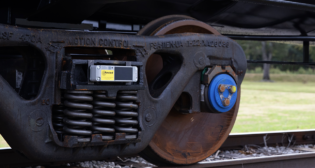
CN train carrying crude oil derails in Canada
Written by William C. Vantuono, Editor-in-ChiefNineteen cars and one locomotive in a 122-car CN train carrying LPG in DOT 112 cars and crude oil in DOT 111 cars derailed and caught fire on Tuesday, Jan. 7, 2014 near the town of Plaster Rock in northwest New Brunswick, Canada. There were no injuries, but about 50 nearby homes were evacuated when the train derailed at approximately 7:00 p.m. EST.
The train originated in Toronto and was headed to an Irving Oil refinery in Moncton, N.B., which is about 185 miles east of the site of the accident, according to Jim Feeny, director of public and government affairs at CN. Among the 19 cars and one unmanned locomotive that derailed were four loads of propane and four loads of crude oil, he said. Unkown at this time is what type of crude oil the train was carrying, though it did originate in western Canada. A fireball was reported but has not been confirmed, and it is unknown at this time whether the fire was oil- or propane-related.
Feeny initially said that CN crews planned to conduct an aerial surveillance of the site to determine the source and scope of the fire, and that more information about the blaze is required before crews can go in and start cleaning up the site. Later Wednesday, Feeny said it appeared that a wheel or axle failure caused the train to derail.
Fire officials said the cars appear to have been mostly empty, except for some propane residue. “They’ll in all probability burn themselves out by morning,” said Sharon DeWitt, emergency measures coordinator for Plaster Rock, soon after the accident. She said there was no danger to residents as the wind was blowing away from Plaster Rock, a village of about 1,000 in a mainly wooded area about 30 miles from the U.S. border and Maine.
The Transportation Safety Board of Canada initially said the derailment was caused by an “undesired brake application.” On January 9, TSB Senior Investigator Guy Laporte said that a cracked wheel has been identified near the front of the train. The broken wheel was split from the axle toward the rim “like the spoke of a bicycle wheel.” The axle itself did not break. The cracked wheel worked its way inward along the axle, causing the gauge to narrow and the wheel to drop inside the rail. The train, consisting of 122 cars, three head-end locomotives, and one remote locomotive, was travelling 47 mph at time of accident. Also, a broken rail was found near the front of the train
The extreme cold weather may have been a factor and will be investigated, said Laporte. He added that the derailment and fire occurred substantially back in the train. At this point in the investigation, no immediate connection has been made between the broken wheel and the derailment. Laporte could not say whether emergency braking caused the hazmat cars to derail.
Last November, Canadian Transport Minister Lisa Raitt issued a directive that requires railroads to provide annual information to municipalities on the volume and nature of hazmat materials being transported through their jurisdictions. The move came in response to the derailment and explosion in Lac-Mégantic, Quebec on July 6, 2013,which killed 47 people.
In a similar move last August applying to U.S. operations, the Federal Railroad Administration issued an emergency order “to help prevent trains operating on main line tracks or sidings from moving unintentionally,” specifically, those hauling certain types of hazardous materials, such as crude oil and ethanol.
CN President and CEO Claude Mongeau went to the scene of the accident and, accompanied by New Brunswick Premier David Nathan Alward, conducted a news conference.
(Railway Age Contributing Editor David Thomas supplied additional information for this article.)



